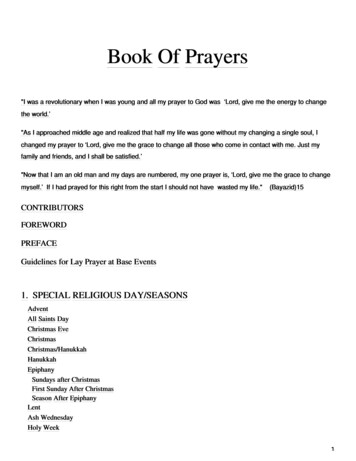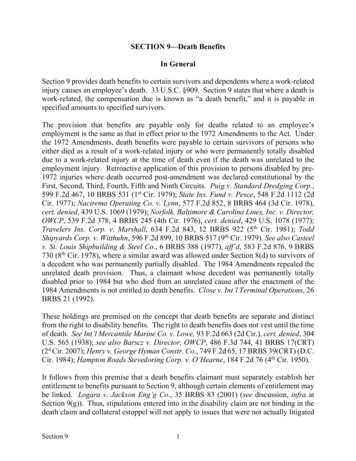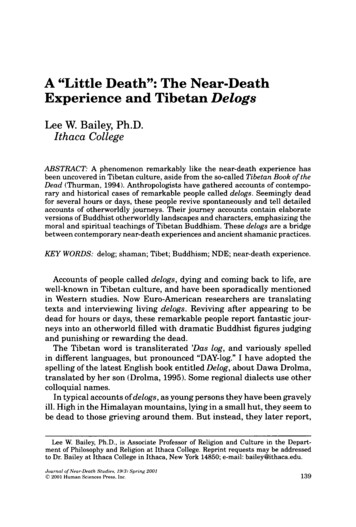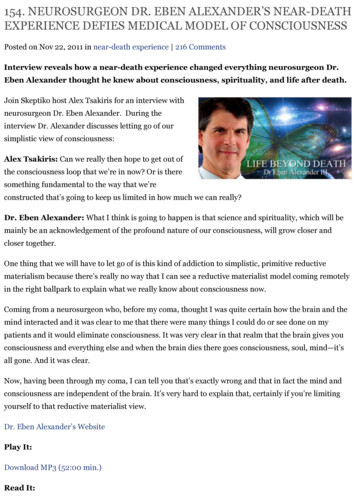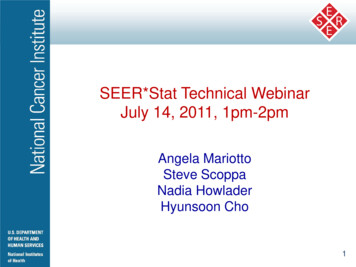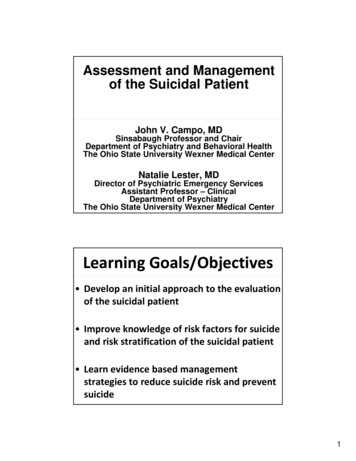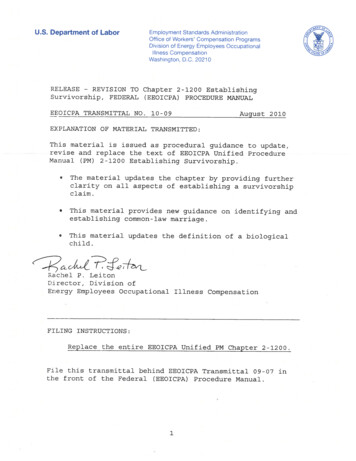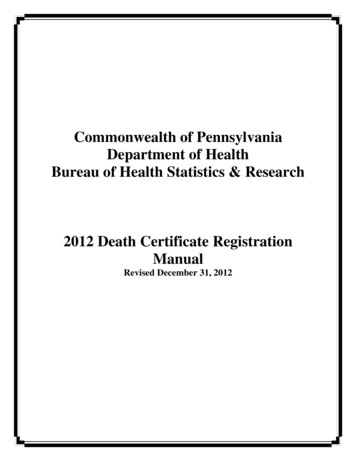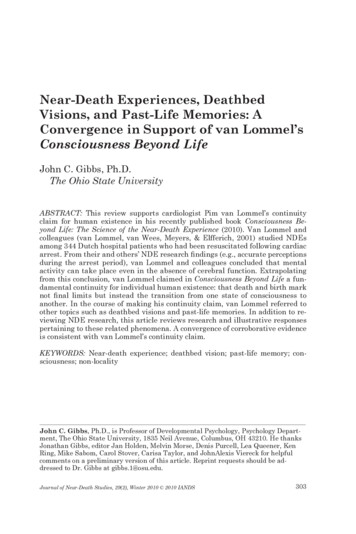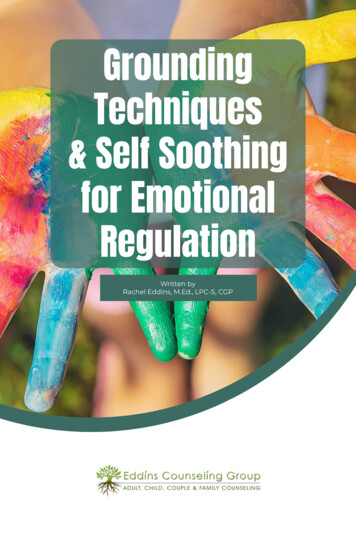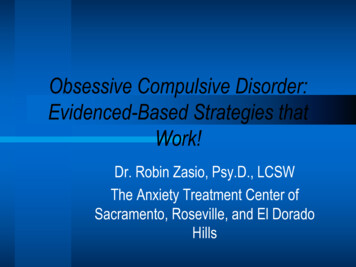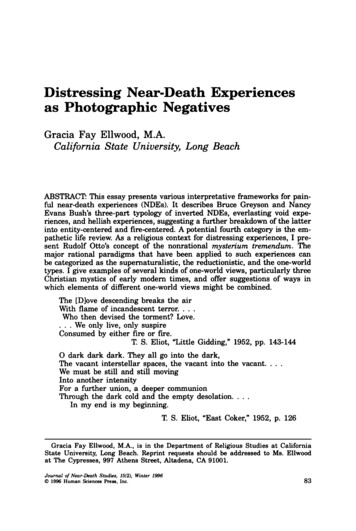
Transcription
Distressing Near-Death Experiencesas Photographic NegativesGracia Fay Ellwood, M.A.California State University, Long BeachABSTRACT. This essay presents various interpretative frameworks for painful near-death experiences (NDEs). It describes Bruce Greyson and NancyEvans Bush's three-part typology of inverted NDEs, everlasting void experiences, and hellish experiences, suggesting a further breakdown of the latterinto entity-centered and fire-centered. A potential fourth category is the empathetic life review. As a religious context for distressing experiences, I present Rudolf Otto's concept of the nonrational mysterium tremendum. Themajor rational paradigms that have been applied to such experiences canbe categorized as the supernaturalistic, the reductionistic, and the one-worldtypes. I give examples of several kinds of one-world views, particularly threeChristian mystics of early modern times, and offer suggestions of ways inwhich elements of different one-world views might be combined.The [D]ove descending breaks the airWith flame of incandescent terror.Who then devised the torment? Love. . . We only live, only suspireConsumed by either fire or fire.T. S. Eliot, "Little Gidding," 1952, pp. 143-144O dark dark dark. They all go into the dark,The vacant interstellar spaces, the vacant into the vacant.We must be still and still movingInto another intensityFor a further union, a deeper communionThrough the dark cold and the empty desolation.In my end is my beginning.T. S. Eliot, "East Coker," 1952, p. 126Gracia Fay Ellwood, M.A., is in the Department of Religious Studies at CaliforniaState University, Long Beach. Reprint requests should be addressed to Ms. Ellwoodat The Cypresses, 997 Athens Street, Altadena, CA 91001.Journal of Near-Death Studies, 15(2), Winter 19961996 Human Sciences Press, Inc.83
84JOURNAL OF NEAR-DEATH STUDIESFor most of the 21 years since Raymond Moody's Life After Life(1975) opened the field of near-death studies on both popular andacademic levels, the focus has been on radiant experiences. However,as early as 1978, Maurice Rawlings' Beyond Death's Door spoke emphatically of the existence of distressing experiences as well; CharlesGarfield reported in 1979 that half of his dying cancer patients haddistressing experiences. Besides the work of these early researchers,occasional isolated cases were published.At that, Beyond Death's Door (Rawlings, 1978) was not the first bookto deal with distressing near-death experiences (NDEs). Glimpses ofthe Beyond, by Jean-Baptiste Delacour, which appeared in the UnitedStates in 1974, a translation of Aus dem Jenseits Zuruck (1973), recounted a variety of purportedly real NDEs that included hellfire anddesolation scenes. The author clearly was familiar with near-deathdata, but his book showed signs of plagiarism and fictionalization,which left the reader unwilling to trust to the accuracy of the cases.Garfield has not published any of his stories at all, so far as I know,making them eminently easy to disregard. Rawlings, on the otherhand, recounted several stories of burning impact. But for some years,comparatively little notice was taken in mainline near-death studies.The basic reasons are not far to seek: the cases are disagreeable, andthey appeared as part of a fundamentalist package that refused criticalanalysis. Besides, as Bruce Greyson (1990) and Nancy Evans Bush (1993)have pointed out, those who have had frightening NDEs tend to be asreluctant to tell them as investigators have been to ask. But as the 1980sprogressed, the existence of distressing cases was acknowledged in severalsignificant works, and alternative interpretations considered.Types of Distressing NDEsEspecially important among recent studies is Greyson and Bush'sessay "Distressing Near-Death Experiences" published in Psychiatryin 1992. Greyson and Bush presented a typology of three major kindsof distressing NDEs.Inverted NDEsThe first type has essentially the same format as the tunnel-andlight blissful NDE, but is perceived by the experiencer as frightening
GRACIA FAY ELLWOOD85instead. Kenneth Ring referred to these with the apt term "invertedNDEs" (Ring, 1994). This kind is sometimes related to rigidity of egoboundaries with fear of loss of control, as evidenced by the changeto a peaceful experience in some cases when the NDEr lets go andaccepts the experience. Though much more can be said about thistype, in what follows I will focus on the second and third types, whichat first view pose greater difficulties, before suggesting a potentialfourth type.Everlasting Void ExperiencesIn the second kind, the experiencer finds her- or himself in a featureless dark void in utter loneliness. In some cases the message isgiven that all of life is a product of one's imagination, a cruel jokethe experiencer was allowed to believe to be real. In any case, allcontact with the world is seen to be permanently cut off, and thepsychological pain is unutterable.An example is the mystical experience of NDEr Peggy Holladay.She came close to death in an auto accident in 1974, and thoughshe did not remember a narrative NDE, NDE-type images emergedinto her consciousness afterwards. Thirteen years later, and fourmonths after a major mystical encounter with the light, she was looking into a mirror one morning and asking herself, "What am I reallyupset about?"Suddenly she found herself on the other side of the mirror, beingdragged by some incredibly powerful magnetic force into a kind ofgray outer space. She was hit (her term) by a conviction that shehad died and was "completely ALONE, never to be with any lovedones, . . . no living thing again in any form." The distress was soextreme that it was as though she was feeling all the pain and fearof every living creature that had ever existed. She screamed "No,no!" and tried desperately to get back into her body, which she couldstill see standing on the other side of the mirror. She finally succeeded in doing so, though for several hours she felt in danger offloating up into space again (P. Holladay, personal communication).Some persons who have void experiences do in fact communicate withentities of some sort, but the sense of emptiness and aloneness maystill be there (Greyson and Bush, 1992).Holladay did not accept the fundamentalist interpretation, whichshe saw as harmful. Since she had already encountered the light,
86JOURNAL OF NEAR-DEATH STUDIESwhich for her was and is unmistakeably ultimate, she saw this painful experience as having a healing and transforming purpose. Butfor NDErs who have known only this kind of experience, it may leavefeelings of despair and increased, rather than decreased, fear ofdeath.It may be significant that Holladay saw both her mirror experienceand her mystical experience of the light as a return to consciousawareness of what had transpired during her brush with death 13years before. Of this I will say more later.Hellish ExperiencesThe third kind of case includes imagery of demons and/or hell. Theexperiencer feels victimized by malevolent entities wanting to dragher or him down into hell, or goes down into a pit, sees or hearsthe sufferings of tortured beings. There is often a pervading senseof evil that awakens great fear in the experiencer (Greyson and Bush,1992). An example may be given from the writings of the 8th-centuryscholar Bede, cited in Carol Zaleski's Otherworld Journeys (1987).The NDEr, a pious Anglo-Saxon householder named Drythelm, succumbed to a severe illness and was met by a shining messenger whoescorted him to a huge valley, one side aflame while the other sideunderwent a hailstorm. Countless souls were tossed back and forthbetween these torments. The guide explained that this was a placeof temporary sufferings and that the souls therein could be releasedfrom these punishments by masses and prayers on the part of theliving.The guide then led Drythelm to hell through a land of darknesstotal except for the guide's light. Hell was a bottomless abyss, stinking and flaming. Damned souls were cast upward on the flames tofall back again amid the sounds of jeering laughter and grief. Malignant spirits dragged three souls into the abyss, and menacedDrythelm, but his guide rescued him.After this Drythelm was led to a realm of light and joy, whichincluded a walled paradisiacal meadow inhabited by many happypeople, and approached heaven, which was similar and more wonderful still. However, despite his wish to remain, he was sent back.The aftermath of his experience was an exchange of his lifestyle forone of monastic austerity. Drythelm told his story to a monk, who
GRACIA FAY ELLWOOD87told it to Bede (Zaleski, 1987); it is, then, a thirdhand account, perhaps not totally accurate, but not the stuff of legend either.This experience reflects cultural ideas of its period-afterdeathpunishment in the form of purgatory and hell, demons, paradise, theauthoritative spiritual leader, ideals of asceticism-yet it also bearsunmistakeable similarities to certain elements in 20th century experiences such as those of George Ritchie and Howard Storm. Ritchie'sexperience is familiar to many from his books Return From Tomorrow(Ritchie and Sherrill, 1978) and My Life After Dying (Ritchie, 1991),but I will summarize it for the benefit of those who have not yetencountered them.Ritchie collapsed of pneumonia and was given up as dead whilein December, 1943. After a disin military basic training inembodied flight in the direction of his home state of Virginia, hereturned to the scene of his body and had a vision of the light andof Christ. The figure of Christ led him to a series of earthly scenesin which he perceived various earthbound spirits trying unsuccessfully to interact with the living and to satisfy cravings for addictivesubstances. He also saw a dark area in which many spirits foughtwith one another or tried to satisfy distorted sexual cravings. Allthese beings were overshadowed by angelic figures who tried patiently to draw their attention to better things. Ritchie was alsoguided to a peaceful university-like setting, and saw but did not entera celestial city before he was induced to return to his body.Storm's experience was told in some detail in Judith Cressey's TheNear-Death Experience: Mysticism or Madness (1994). After sufferingprolonged agony from a perforated duodenum, Storm succumbed andwas astonished to find himself standing by his bedside looking athis body. His wife and roommate failed to respond to him, and hereacted with anger. Then he was enticed by seemingly helpful entitiesthrough a doorway onto a darkening plain where they eventually attacked him savagely. They finally backed off protesting when, in response to the urging of an inner voice, he tried to pray. After a periodof intense desolation (the void experience?), again in response to hisown voice within, he called to Jesus for help and was rescued by astarlike angelic figure who surrounded him with love, took himamong other loving beings, and taught him extensively (Storm, 1989).In these, as in the case of Drythelm, we note the journey throughdark realms, angelic compassion for those suffering after death, violent entities, the power of prayer, the rescuing guide, light piercingthe darkness, and scenes of pain giving way to scenes of bliss.Texas
88JOURNAL OF NEAR-DEATH STUDIESEntity-Centered vs. Fire-Centered Hellish Experiences.Drythelm's case presented both malicious entities and hellfire, asdo some contemporary cases, thus seeming a particularly apt example of the hellish category. However, there are also cases such asRitchie's and Storm's involving entities but no fire, and I proposethat they be considered a separate subcategory, because some entitiesshow distinct analogies to figures in certain more familiar situations,namely schizophrenia and nightmares. Rarely, they also intrude intoradiant NDEs, as at the end of Betty Eadie's experience (Eadie andTaylor, 1992).One source supporting such a connection is The Presence of OtherWorlds by clinical psychologist Wilson Van Dusen (1974). In it hedistilled the results of 16 years' investigation into the visionary (Iavoid the word hallucinatory) figures perceived by schizophrenic patients. Taking the voices seriously and in many cases interviewingthem through the patients, he found pervasive similarities amongthe entities. The majority, which he called "the lower order," manifested lies, inflated claims, threats, perseveration, malice, lack of distinct personal identities, masquerading, obsessions, and pervertedsexuality; and all the lower order showed hostility toward anythingto do with religion. About one-fifth of the visionary figures were, bycontrast, loving and supportive, and offered profound symbolic wisdom (Van Dusen, 1974). I suggest this analogy not to dismiss theseNDEs as incidents of psychosis, which they clearly are not, but toprepare the ground for paradigms that will relate these and otherclasses of experience.As has been pointed out in the case of radiant NDEs, distressingNDE-like experiences also take place at times when there is no question of nearness to death. Persons in waking consciousness and normal health have experienced malevolent otherworldly entities. In oneof the few contemporary cases I know, the experiencer, Gary Wells,was going through a period of psychological and spiritual distress.While alone at work during a night shift he appealed to God ".if you do exist, please let me know." In response he felt a powerfuldivine presence that gave him a strong sense of his own uncleanness,and commanded him to be holy. This command he resisted. An excruciating headache followed, then a sudden experience of blacknessand "a dank, unearthly smell. " He heard voices of two men abusingone another in
GRACIA FAY ELLWOOD89phony, foul language. There were more voices inside the blackness,but they were further away and faint. I felt a power like a vacuumpulling me into it further. As I moved toward the source, my speedincreased proportionately. (G. Wells, personal communication, 1994)He heard his own voice yelling to God for help, and suddenly thescene was gone. This was followed by a powerful, enlivening senseof the presence of the Holy Spirit.In another case, Norman Van Rooy as a child of 4 or 5 one eveningheard his name called as he lay in bed before going to sleep.There was a kind of humming . or throbbing sound like electricityin a transformer. . . . It had a malevolent intelligent magnetismthat was almost hypnotic. The sound was coming from the wall.As I watched in horror the wall opened up in several places nearthe floor and out of each opening came a creature. These wereshaped like the bottom sides of goat's hooves. I felt helpless as theybeckoned me to come with [them]. Between the cloven hooves fromwhere their voices came a nexus of overwhelming magnetic malevolent intelligence pulsated with a fiery glow. They seemed to knowme and were trying to pull me down with them. This frightenedme terribly and I called out for help to my mother who was in thenext room. When she entered the room the entire scene disappeared. When she left this event was repeated. I felt weaker and sensedI could not resist and would be sucked into their subterraneanworld. Again I cried out and again my mother's presence dispersed[them]. . . . I fell asleep. . . . The next night this was repeated.After that I never re-experienced anything remotely similar to it.(N. Van Rooy, personal communication, 1994)The fact that Van Rooy's experience happened in bed in the eveningmay prompt some readers to interpret it as a nightmare. Unless oneis given to reductionism, there is no reason to doubt that it was awaking experience just as he recounted it. There are, however, analogies between the experience and nightmares peopled by menacingfigures, especially those that are not a processing of past traumaswhich fact suggests that rather than his vision being "merely" anightmare, the malevolent figures in certain nightmares may in factbe a form of the same kind of entity, possessing a kind of reality oftheir own.Both these not-close-to-death experiences centered around evil entities and an evil force, and there is a hint of hellfire in the secondone. But there are also cases, both NDEs and not-close-to-death experiences, that center around hellfire but have no entities, or whoseentities lack power or malevolence. Rawlings cited two of them inBeyond Death's Door (1978). One was the case of Thomas Welch, who
90JOURNAL OF NEAR-DEATH STUDIESfell from a trestle high over a dam. He found himself near the shoreof an awe-inspiring lake of blue fire. Deceased persons he had knownwere there, looking bewildered and incredulous. He was rescued bythe figure of Jesus, who turned and looked at him. Then he wasback in his body.One can also find accounts of hellfire-centered not-close-to-deathexperiences in the lives of saints and mystics.of Avila-whomay have been an NDEr, having once been in a deathlike comawhile praying suddenly found herself in hell: a long narrow passage,whose ground was covered with malodorous mud full of reptiles,which led to a small cavity in a wall in which she was then confined.She suffered physical-seeming agonies of being both burned and dismembered, in terrible despair because of her conviction that thiswould be forever. She did not tell how she escaped (Teresa of Avila,1957). I mention Teresa's case, which was quoted at some length inChristopher Bache's "A Perinatal Interpretation of Frightening NearDeath Experiences" (1994), because she also had a not-close-to-deathexperience in which a fiery spear pierced her heart; she interpretedthe fire as divine love-a common image among Christian mysticsand found it both blissful and agonizing at once. I will develop someof the implications of this ambivalence below.P.M.H. Atwater, in Beyond the Light (1994), noted that spinningvortices and other whirling patterns turn up in some distressingNDEs, as well as in her own radiant third NDE. Marcel LouisForhan ("Yram"), who in his book Le Medicin de l'Ame (translatedas Practical Astral Projection) described having out-of body experiences virtually at will, mentioned vortex-like energies that wouldsweep his projected self away into sometimes unpleasant situations(Yram, 1974). With knowledge of more cases, we may find the vortex-centered distressing NDE to be a third subcategory.TeresaThe Empathetic Life ReviewIn addition to Greyson and Bush's three types, a possible fourthtype of (partially) distressing NDE is the painful empathetic life review. The empathetic life review was described in Moody's Reflectionson Life After Life (1977) in a chapter entitled "Judgment." He citedcases of persons who experienced not only every detail of their livesbut also the impact of their lives on others. He suggested that peoplewho have done great harm, such as perpetrators of the Nazi horrors,
GRACIA FAY ELLWOOD91seeing all the suffering they have caused, and by implication, feelingit, would undergo the worst sort of hell imaginable. Atwater, hardly asinner in the Nazi league, also used the word "hell" to describe her empathetic life review, which included the effect of her life not only onother people but on animals, plants and the so-called inanimate world:"It was a reliving of the total gestalt of me as Phyllis, complete with allthe consequences of ever having lived at all" (Atwater, 1988, p. 36).Dannion Brinkley, in Saved by the Light, wrote that in his empathetic life review he not only received all the violent kicks andpunches he had delivered in the thousands of fights of his youth,but felt the death-throes of the people he killed in Laos and Cambodia, the suffering of their families afterwards, and also the deathsof civilians killed in his presence by other military personnel(Brinkley and Perry, 1994). He also mentioned feeling the sufferingof a dog he had once beaten for a minor misdeed, as well as therelief of a goat whom he had rescued from another's abuse.To experience the effects of one's life may seem like an exact sortof recompense-perfect justice-for the Adolf Hitlers of this world.But "all the consequences of ever having lived at all" includes unintended consequences as well as future generations. Suppose we moveback a generation: did Kiara Hitler, a doting mother who lacked thecourage to protect the child Adolf from the savage abuse of his father(Miller, 1990), deserve to experience the entire Holocaust and all therest of the horrors of the war?No returned NDEr has described in any detail a "ripple effect" ofthis magnitude, but the fact that most are limited does not meanthat the ripple effect does have limits. It may be a preliminary formof the vision of knowledge that Moody's subjects and other NDErsdescribed when they said things like "There was a period in whichI knew everything." But knowing everything may be a decidedlymixed blessing. If the sins of the children, generation after generation, are visited upon the fathers and mothers, we have indeed asituation that often could rightly be called hell, though it is not exactly an otherworldly state but a retrospective hell on earth.Otto's Mysterium TremendumThe history of religions can be helpful in providing contexts forthe phenomenon of distressing NDEs. Of particular value is theanalysis of the German thinker Rudolf Otto presented in his classic
92JOURNAL OF NEAR-DEATH STUDIESwork Das Heilige, translated into English as The Idea of the Holy(1958). Otto's analysis is relevant to Greyson and Bush's three maintypes, but not to the empathetic life review.He asserted that the essence of deity is not expressible in intellectually meaningful categories, but that so-called divine attributesare rationalizations applied to the human experience of the Holy,which is an encounter with a nonrational Something that he described as the Mysterium tremendum et fascinans, the Dreadful andFascinating Mystery. He coined the term "numinous," from the Latinnumen divinity, to express this sense of a felt presence that is soalien to our everyday world, so uncanny, that the mind that encounters it is struck with blank astonishment, with awe. The hair-raisingfeeling aroused by ghost stories is, wrote Otto, a degraded form ofthe response to the Mystery. It is because the Mystery is so totallyOther that words fail to describe it.The dreadful aspect of the numinous perception is not merelydread in the sense of fear of a this-worldly threat; it involves a shudder of supernormal horror, the feeling of the blood running cold. Ottosaw an early expression of this kind of experience in the concept ofthe Wrath of God in the Hebrew Scriptures. In many passages itseemed clear that this Wrath had no concern at all with moral qualities; the ways in which it was aroused were baffling. It is " 'like ahidden force of nature,' like stored-up electricity, discharging itselfupon anyone who comes too near" (Otto, 1958, p. 19). But the term"wrath" is an image, wrote Otto, an attempt to understand the experience by applying the analogy of human anger.Carrying the analysis further, Otto remarked that there is something enormous and overpowering about the Dreadful Mystery. Bycontrast, the human self is puny virtually to the point of nonexistence; one cannot even consider pitting oneself against it. Thirdly,there is an element of intense energy about the Dreadful Mystery.It is alive; it is at the furthest possible remove from mere philosophical abstractions. In some forms of mysticism it appeared as the" 'consuming fire' of love whose burning strength the mystic canhardly bear" (Otto, 1958, p. 24).The same mysterious Something that arouses astonishment, awe,and dread also arouses a powerful fascination in the one who perceives it. The experiencer of this fascination "feels a strange ravishment, rising often enough to the pitch of dizzy intoxication" (Otto,1958, p. 31). As with wrath, the conceptions of this Fascinating Mystery as comfort or security or the joy of love are inadequate images
GRACIA FAY ELLWOOD93for the unutterable bliss it conveys. Many means are employed toseek out the Mystery, including magical operations and severe asceticism. One may begin by seeking it for what one has to gain byit, but will sooner or later seek it for its own sake (Otto, 1958).Otto did not mention the near-death experience; his analysis wasbased on his study of traditional religious phenomena from manytimes and places. Yet his Dreadful and Fascinating Mystery describedremarkably well the feeling tone of heavenly NDEs and hellish-typedistressing NDEs. His analysis is helpful for our purposes for at leasttwo reasons. One is that it validates the existence of hellish NDEsas part of a wider spectrum of baffling religious phenomena. Theother is that he asserted from the outset that these phenomena arenonrational; he attempted to get below any interpretation and valuation to explore the nonrational core of the experiences.In fact he did not quite succeed in getting beyond interpretation,as can be seen, for example, in his assumption that the Dreadful experiences and the Fascinating experiences are all encounters with thesame reality. There are mystical experiences that clearly manifestboth qualities, as in the case of Teresa's fiery spear, but in other cases,in which only the one or the other quality is present, it is not evidentthat both are of the same kind. Further, it must be admitted that insome NDEs the interpretation is not merely imposed in retrospectbut is unmistakeably part of the imagery of the experience. An example is the painful case of NDEr A.B., published in the newsletterof the Seattle LANDS group. Overwhelmed by darkness, a loud bell, andthe screams of seeming thousands, badly frightened, she was warnedthat the sin of adultery in her life had led to this pass (A.B., 1991).However, it is still profitable to follow Otto and regard interpretations of NDEs as at least to some extent secondary to the basic encounter, as this enables us to put various interpretations side by sideand evaluate them. Interpretations are meaning structures, part ofthe overarching meaning structure that is a culture's worldview. Thecore principles of a meaning structure are selection and subordination; by this means patterns are shaped and perceived. Without necessarily being aware of it, when we look at a field of data, we seethe polarity of figure and ground; for example, when we read welook at the black shapes on the page, ignoring the white configurations inside and around them.Another important polarity is that of good and bad, which is obviously important when considering heavenly and hellish experiences. Complications arise, however, which will be considered later.
JOURNAL OF NEAR-DEATH STUDIES94A third polarity of meaning structures is the real versus the illusory.For example, those who hold to the reigning scientistic worldview inour culture explain away heavenly and hellish visions alike by callingthem hallucinations, that is, claiming they are illusory. Many readersof this Journal would instead take an opposite tack, asserting thatthe heavenly NDEs, at least, are real. But there are also complications here which will be gone into later.Immanuel Kant's critical philosophy took the lead in making Westerners aware that worldviews are created and sustained by humanbeings. This happens in thousands of complex and subtle ways; limited human beings cannot see reality bare without them. Some thinkers have assumed that this means that reality, as it is in itself, ischaotic, perhaps meaningless; certain psychedelic and mystical experiences, and the everlasting void type of distressing NDE, tend tofoster this idea. But we need not commit ourselves to it; for all weknow, reality itself may in fact approximate to some particular worldview, or a roughly accurate worldview may be gleaned by carefulcross-cultural comparisons.In any case, we cannot think without a worldview, and those whoexplore near-death studies have to fit distressing experiences into itsomewhere if we are to be honest enough to admit their existence.For this reason I do not join Otto in calling the Dreadful and Fascinating Mystery simply nonrational, but will try to bracket the issuewhile I outline some basic interpretations of how the two kinds ofexperience relate to one another and to everyday life.Types of Rational Paradigms for Explaining NDEsInterpretations are largely of three kinds, which I will call the supernaturalistic, the reductionistic and the one-world types, my typology being developed from philosopher David Griffin's typology ofphilosophical animism and dualism (Griffin, 1993).SupernaturalisticParadigmsSupernaturalistic thinking has shaped the major Western religionsand influenced the rise of modern science, so it is very familiar tous. Essentially, it gives us a crucial division: on the one hand a sovereign God and the world of pure spirits; on the other hand the public
GRACIA FAY ELLWOOD95physical world. God is all-powerful, and creates and rules everythingin both worlds. Physical things are "dead" and and can only reactaccording to the physical laws God has set; they have no choice ofany sort. But we human beings may choose to obey or disobey God'smoral laws.some extent we may get our rewards and punishmentsin this life, but that cannot be counted on; what can be counted onis heaven for the obedient or hell for the unrepentant after death. Inthis interpretation, then, to oversimplify, hellish NDEs reflect experience of a state that is God's work, the expression of his rage at humandisobedience. If demons are involved, they are carrying out God's will.A variant on this hell-as-punishment interpretation has alreadybeen noted in the case of Drythelm: purgatory, as a third state between heaven and hell. Here suffering still results from sin againstGod, but rather than being an expression of God's retaliatory anger,it is m
as Photographic Negatives Gracia Fay Ellwood, M.A. California State University, Long Beach ABSTRACT. This essay presents various interpretative frameworks for pain ful near-death experiences (NDEs). It describes Bruce Greyson and Nancy Evans Bush's three-part typology of inverted NDEs, everlasting void expe
